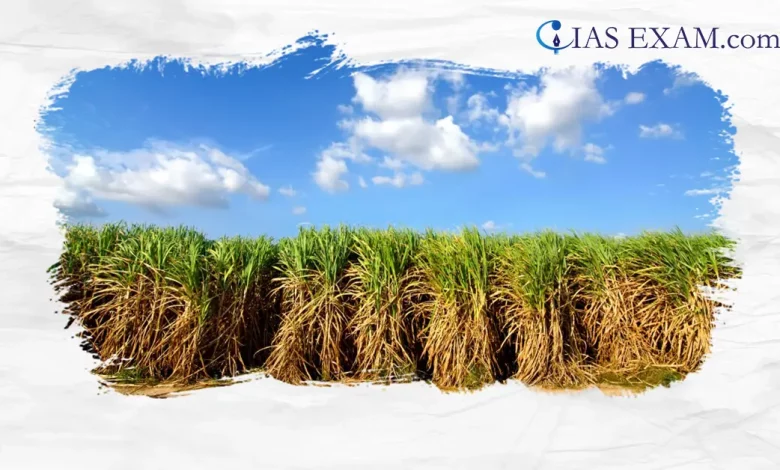
Context:
The Prime Minister-led Cabinet Committee on Economic Affairs has approved the Fair and Remunerative Price (FRP) for sugarcane for the upcoming Sugar Season 2024-25 at ₹ 340 per quintal with a sugar recovery rate of 10.25%.
Fair and Remunerative Price (FRP):
- The Fair and Remunerative Price (FRP) is the price set by the government that a mill is ought to pay to the farmer for the cane they procure.
- On the other hand, farmers have the right to either accept immediate cash or the FRP payment in instalments after signing an agreement with the mills. Delays in clearing the dues can attract interest charges and the commissioner is given powers to seize unallocated dues through attaching properties of the mills.
- The Sugar Cane Board is responsible for the execution of the payment of FRP which is governed by the Sugarcane Control Order, 1966, under the Essential Commodities Act, 1955, that requires payment of the cane within 14 days from date of cane delivery.
- FRP is fixed by the Commission for Agricultural Costs and Prices and honoured by the Cabinet Committee on Economic Affairs.
- The CACP gives recommendations for consideration to the government, and the CCEA, a body headed by the Prime Minister, makes the final decisions.
- FRP refers to the suggestions of the Rangarajan Committee appointed to restrengthen sugarcane industry.
Details about news:
- Sugar mills will now be required to pay a Fair and Remunerative Price (FRP) of ₹340 per quintal of sugarcane with a recovery rate of 10.25%.
- Farmers will receive an additional ₹3.32 for every 0.1% increase in recovery rate, and the same amount will be deducted for every 0.1% decrease in recovery rate.
- The minimum price for sugarcane is ₹315.10 per quintal with a recovery rate of 9.5%.
- Even if the recovery rate is lower, farmers are still guaranteed the minimum price.
- The revised FRP will be implemented from October 1, 2024.
- The new FRP is 107% higher than the cost of production for sugarcane.
- Despite already having the highest price of sugarcane in the world, the Indian Government is ensuring affordable sugar for domestic consumers.
Sugarcane:
- Sugarcane, an African tropical grass in the grass family, accumulates saccharides in its stem.
- It is used mostly for sugar,jaggery, khandsari and molasses.
- The Indian States with the highest sugarcane production are – Uttar Pradesh, Maharashtra, Karnataka, Tamil Nadu, and Bihar.
- The sugarcane crop requires a temperature range between 21 to 27°C, hot and humid climate, good rainfall and well-drained loamy soil for its optimum growth.
- At the end of 2021-2022 India became the world’s largest sugar producer, surpassing Brazil, that crop year being the most successful with a production record of 359 lakh tonnes.
Cost of sugarcane:
- The Central Government determines the Fair and Remunerative Price (FRP) for sugarcane which is in accordance with the suggestions from the CACP and got the Cabinet Committee on Economic Affairs’ approval.
- States usually indicate State Administered Price (SAP) and the SAP is often higher than the FRP.
Sugar Price:
- Prices of sugar are affected by market forces in the form of changes in supply and demand which may result in price increases or decreases.
- In 2018, an MSP for sugar was introduced in a bid to safeguard farmers’ interests.
- The MSP consists of two components: Fair and Remunerative Price (FRP) for sugarcane and Make in India program.
- The price of sugarcane foreturned from SMP to FRP in 2009-10. The central government, together with the state authorities and industry associations, determine the sugarcane price through a joint consultative process on the basis of recommendations made by the Commission for Agricultural Costs and Prices (CACP)
Conclusion:
- Increasing the Fair and Remunerative Price (FRP) for sugarcane would directly benefit over 5 crore farmers and their families, as well as many others in the sugar industry, by helping to double their income.
- The FRP guarantees farmers a certain profit, regardless of the profitability of sugar mills.
- This policy will be implemented nationwide, with some states also setting their own State Advised Prices above the FRP.
Source: PIB
UPSC Prelims Practice Question:
Q.The Fair and Remunerative Price (FRP) of sugarcane is approved by the:
Which of the statements given above is/are correct?
a. Cabinet Committee on Economic Affairs
b. Commission for Agricultural Costs and Prices
c. Directorate of Marketing and Inspection, Ministry of Agriculture
c. Agricultural Produce Market Committee
Ans: “a”





.png)



